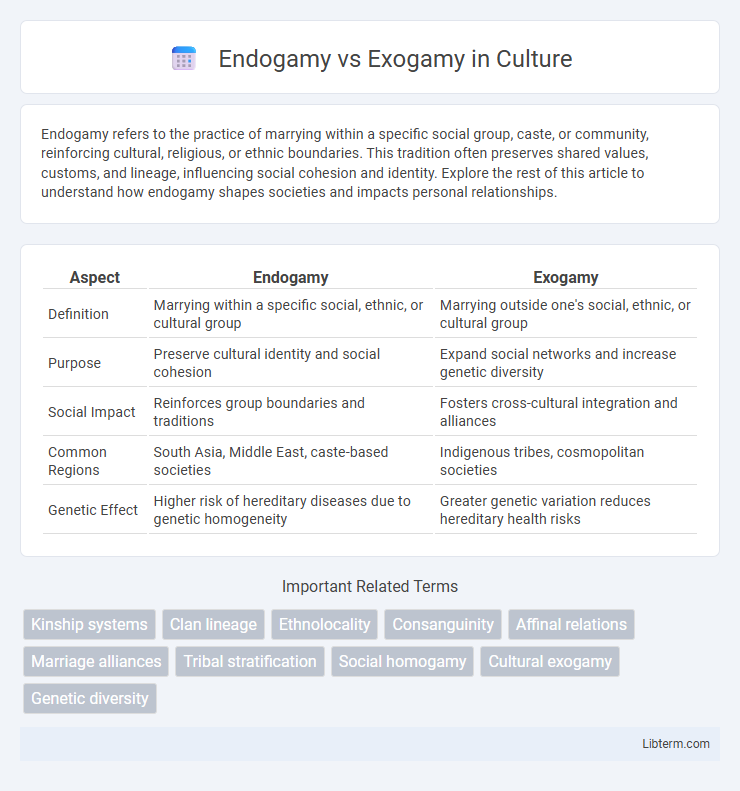Endogamy refers to the practice of marrying within a specific social group, caste, or community, reinforcing cultural, religious, or ethnic boundaries. This tradition often preserves shared values, customs, and lineage, influencing social cohesion and identity. Explore the rest of this article to understand how endogamy shapes societies and impacts personal relationships.
Table of Comparison
| Aspect | Endogamy | Exogamy |
|---|---|---|
| Definition | Marrying within a specific social, ethnic, or cultural group | Marrying outside one's social, ethnic, or cultural group |
| Purpose | Preserve cultural identity and social cohesion | Expand social networks and increase genetic diversity |
| Social Impact | Reinforces group boundaries and traditions | Fosters cross-cultural integration and alliances |
| Common Regions | South Asia, Middle East, caste-based societies | Indigenous tribes, cosmopolitan societies |
| Genetic Effect | Higher risk of hereditary diseases due to genetic homogeneity | Greater genetic variation reduces hereditary health risks |
Introduction to Endogamy and Exogamy
Endogamy refers to the social practice of marrying within a specific group, caste, or community to preserve cultural, religious, or ethnic identity. Exogamy involves marrying outside one's social group, promoting genetic diversity and forming alliances between distinct communities. These contrasting marriage systems significantly influence social structures and kinship patterns across diverse cultures.
Defining Endogamy: Concept and Characteristics
Endogamy refers to the social practice of marrying within a specific cultural, ethnic, or social group to preserve cultural identity and social cohesion. Key characteristics include restrictions on spouse selection based on shared traits such as caste, religion, or community membership. This practice reinforces group solidarity and maintains traditional values by limiting external influences in marital unions.
Understanding Exogamy: Meaning and Features
Exogamy refers to the social practice of marrying outside one's specific social group, clan, or community to promote genetic diversity and broader social alliances. Key features of exogamy include prohibitions on marriage within certain kinship circles and an emphasis on forming external bonds that strengthen intergroup relations. This practice contrasts with endogamy, where marriage is restricted within a defined group, highlighting exogamy's role in enhancing social cohesion across diverse populations.
Historical Context of Endogamy and Exogamy
Endogamy has historically been practiced to preserve cultural, religious, and social boundaries within communities by encouraging marriage within specific groups, such as clans, castes, or ethnicities. Exogamy emerged in various societies as a mechanism to establish alliances between different groups, promoting genetic diversity and social cohesion beyond immediate kinship circles. Archaeological and anthropological evidence indicates that early human societies employed both endogamous and exogamous patterns depending on environmental pressures and social organization.
Cultural Significance and Social Functions
Endogamy reinforces cultural identity and social cohesion by encouraging marriage within a specific group, thereby preserving traditions, language, and shared values. Exogamy promotes social alliances and genetic diversity by connecting different communities or kinship groups, which can lead to expanded networks and resource exchange. Both practices serve crucial social functions in regulating marriage patterns, maintaining group boundaries, and ensuring social stability through defined relational norms.
Effects on Family Structure and Relationships
Endogamy reinforces family cohesion by preserving cultural, social, and economic continuity within a specific group, often resulting in stronger kinship bonds and shared values. In contrast, exogamy introduces diverse genetic and cultural influences that can expand social networks, promote alliances between different communities, and reduce the risks associated with genetic disorders. The choice between endogamous and exogamous marriage patterns significantly shapes family dynamics, inheritance practices, and long-term social integration.
Impact on Genetic Diversity and Population Health
Endogamy, the practice of marrying within a specific group, can lead to reduced genetic diversity, increasing the risk of inherited disorders and population-specific diseases. Exogamy promotes genetic mixing between different populations, enhancing genetic diversity and reducing the prevalence of detrimental hereditary conditions. Populations practicing exogamy generally experience improved overall health and greater resilience to environmental changes due to a broader gene pool.
Challenges and Controversies in Modern Society
Endogamy, the practice of marrying within a specific social group, often faces challenges related to social exclusion, limited genetic diversity, and reinforcement of social inequalities. Exogamy, marrying outside one's social group, can provoke controversies surrounding cultural assimilation, identity loss, and community cohesion. Both practices raise complex debates in modern society about tradition, individual choice, and social integration.
Endogamy and Exogamy Across Different Cultures
Endogamy and exogamy represent distinct marriage practices that vary widely across cultures, with endogamy emphasizing unions within a specific cultural, ethnic, or social group to preserve heritage and social structure. Many South Asian and Jewish communities practice endogamy to maintain cultural continuity and religious traditions, while indigenous tribes in Africa often embrace exogamy to forge alliances and promote genetic diversity. The choice between endogamy and exogamy reflects deeply rooted social norms and values that shape community identity and cohesion globally.
Conclusion: Navigating Tradition and Change
Endogamy and exogamy represent contrasting marriage practices rooted in cultural traditions that shape social structures and kinship patterns. Understanding these practices involves recognizing the balance between preserving heritage through endogamy and promoting social diversity and alliance-building via exogamy. Navigating the interplay of tradition and change enables societies to adapt marriage customs in ways that respect cultural identity while embracing social evolution.
Endogamy Infographic

 libterm.com
libterm.com